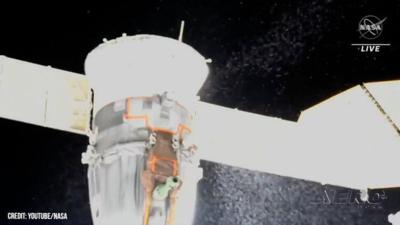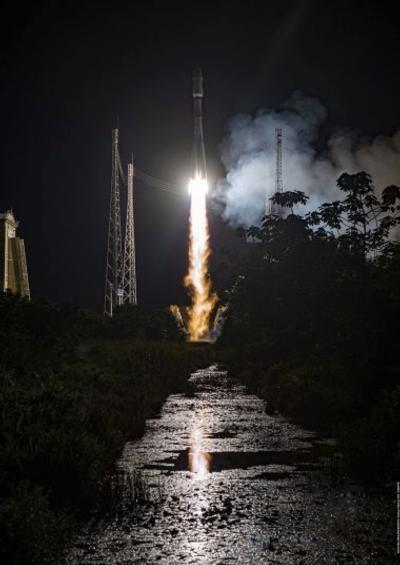Fri, Jan 13, 2023
Meteoroid Strike Damages Spacecraft, Ending Reentry Plans
Russia's space agency plans to launch a replacement Soyuz capsule to the International Space Station next month, replacing the damaged module in orbit.

The move comes after a micrometeoroid strike that perforated a portion of the MS-22 spacecraft, leading to a visible coolant leak from the outside. The capsule could no longer regulate interior temperatures, projected to creep north of 100º during reentry. With such damage, a trip back to Earth aboard the Soyuz is impossible, stranding the personnel in orbit. A new MS-23 Soyuz will be launched on February 20 from the Baikonur Cosmodrome in Kazakhstan. Luckily for the team, the replacement was already slated for launch next March, so advancing the schedule by a month is a relatively minor change of plans.

The new spacecraft will offer NASA and Roscosmos astronauts both a safe capsule and a ride home for those who could conceivably have been left stranded on the station in the event of an emergency. Since the December 14th coolant leak, the astronauts on the station have only had the SpaceX Dragon as a lifeboat - meaning only 5 of the 7 on the station could count on a safe return to earth. The new capsule will likely be used to return astronauts Frank Rubio, Sergey Prokopyev, and Dmitry Petelin, but staff says that there's a good amount of wiggle room as to when such a voyage would occur.
Rubio & co. will most likely wait a few extra months, since MS-23's fresh replacement crew will not be accompanying their Soyuz to the station. They'll now wait for MS-24 to be completed. Their original 6-month mission began in September of 2022, meaning that they could well be up in space for a year before their relief crew is ready for launch. NASA is weighing delays to its own Crew-6 launch in mid-February to possibly help Roscosmos balance out their launch schedules for greater efficiency.
Of interest is that MS-23 will have to use MS-22 as a donor 'car' of sorts. The cosmonauts will take their custom seat liners, Sokol entry suits, and gear to their new ride home before sending it back to Earth uncrewed.
More News
He Attempted To Restart The Engine Three Times. On The Third Restart Attempt, He Noticed That Flames Were Coming Out From The Right Wing Near The Fuel Cap Analysis: The pilot repor>[...]
Make Sure You NEVER Miss A New Story From Aero-News Network Do you ever feel like you never see posts from a certain person or page on Facebook or Instagram? Here’s how you c>[...]
From 2009 (YouTube Edition): Leading Air Show Performers Give Their Best Advice for Newcomers On December 6th through December 9th, the Paris Las Vegas Hotel hosted over 1,500 air >[...]
Aero Linx: NASA ASRS ASRS captures confidential reports, analyzes the resulting aviation safety data, and disseminates vital information to the aviation community. The ASRS is an i>[...]
“For our inaugural Pylon Racing Seminar in Roswell, we were thrilled to certify 60 pilots across our six closed-course pylon race classes. Not only did this year’s PRS >[...]
 NTSB Final Report: Rutan Long-EZ
NTSB Final Report: Rutan Long-EZ ANN FAQ: Turn On Post Notifications
ANN FAQ: Turn On Post Notifications Classic Aero-TV: ICAS Perspectives - Advice for New Air Show Performers
Classic Aero-TV: ICAS Perspectives - Advice for New Air Show Performers ANN's Daily Aero-Linx (06.28.25)
ANN's Daily Aero-Linx (06.28.25) Aero-News: Quote of the Day (06.28.25)
Aero-News: Quote of the Day (06.28.25)




